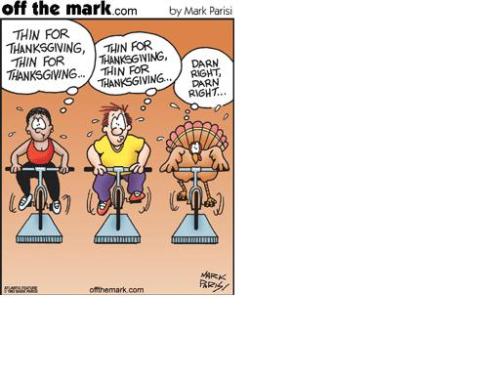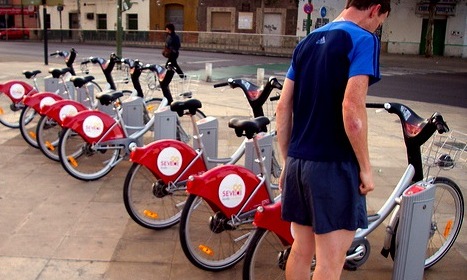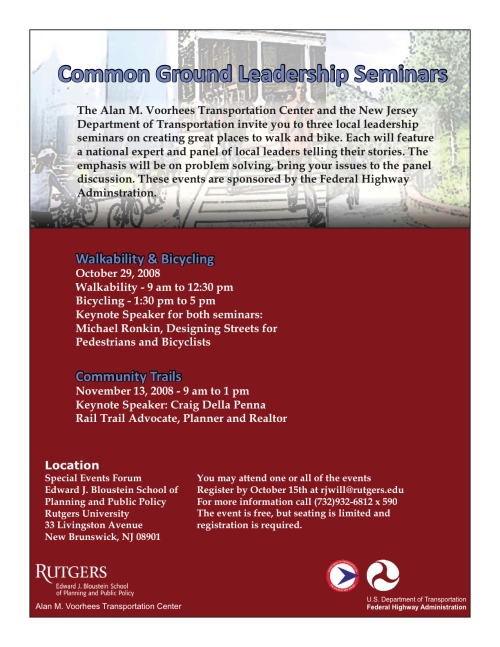Just because the temperture drops below 50F and the sun sets around 5:30 doesn’t mean it is time to hang up your bike for the season. Biking in the winter is a great way to beat the slow, snow-ridden commutes and keep of that “winter weight”. Here are some tips from allweathersports.com that will help keep you out on the bike during the months ending in -er or -uary.
|
|
Remember that all of the tips here can be applied to a wide range of temperatures and conditions. Use your judgement as to what you need to make your winter riding more enjoyable! Go there directly with this index: Our Iditasport Tip Sheet also has valuable information that you can apply to a variety of cold-weather riding conditions. For your Viewing pleasure, we feature a winter riding photo gallery! We haven’t had much of a chance to organize this stuff, so be prepared to have 250K of JPEGs thrown at you. |
Tires
Boazobeanna front and rear are the best tires we’ve found for soft snow. Use low pressure: start with 15-20 psi and experiment for yourself. Sometimes 5 psi feels great. Glue tires to rims: Use tubular tire glue or any strong contact cement in about 6 six-inch strips. Only glue one side. We always glue the right side so we don’t have to try to figure it out in the dark. Snow Cat rims improve flotation, traction and stability on snow or ice. Studded tires improve traction on ice. Chains improve traction on snow or ice but dig themselves in on soft snow and give a rough, slow ride on pavement. Lubrication
On the other hand, bicycles that are used regularly end up with more dirt and water than grease in their bearings and yearly repacking will make them last a lot longer So repack bearings in the fall with low temperature grease and call it winterizing. We test greases for winter bike use by putting them outside when it’s minus 40 degrees (F) or colder. Some “low temperature ” greases get a lot stiffer than others at those temperatures. The best we’ve found so far is Lubriplate Mag-1. We have a lubricant for cables that stays liquid at minus 40 degrees (F). This can help your bike shift better in winter. Goretex RideOn cables require no lubrication, so they work well no matter how cold they are. Lighting
White strobes are brighter and are visible at a greater distance but alone they don’t meet legal requirements. Also, they blink less frequently, making it harder for drivers to see your position and direction. Flashers are best mounted on your bike or rear rack, where they can be aimed precisely, rather than on clothes or packs, where they shift around. Many people install more than one rear flasher. Headlights that meet the state requirements also start at about $16 These are basic, non-rechargeable lights that will make you legal, let you be seen and help you see under some conditions. This is often enough. However, people who ride longer distances and in all conditions usually use more powerful lights. One popular high-power system uses dual beams, produces 35 watts and costs $300. There are many systems available between these extremes. Each system offers a particular combination of power, endurance, weight and price. Winter trail riding requires surprisingly little light; 4-5 watts is plenty The snow reflects well and there are no other light sources so your eyes can adapt to low light. If the moon is bright or the clouds are reflecting light from the city, try turning your light off. For long trail rides try installing a lower wattage bulb to get more battery life. Make sure to match bulb and battery voltages. Generator lights don’t work well in wet or snowy conditions and often don’t give enough light at slow winter speeds. The less sophisticated ones give no light when you’re not moving. Systems that power the taillight and headlight from the same battery may leave you invisible from the rear if a wire breaks.without your knowing it. Independent rear flashers are very reliable and can run for at least a year on 2 AA cells. Reflectors are available as vests, straps, tape and plastic pieces that mount to bicycles. Clear (white) reflectors return twice as much light as amber ones and more than three times as much as red ones Riding Technique
When the bike starts going sideways, make small corrections rather than oversteering and weaving down the trail. Practice riding in a straight line when the trail is good so it’s easier under bad conditions. On some soft trails, higher speeds take less effort than lower speeds.because your tires sink into the snow less at higher speed. When riding in a group on soft trails, have the weaker, less skilled or badly equipped riders lead so they can use the trail before the better riders cut it up. Snow machines leave the center of the trail soft. Their best tracks are left by their skis, if you can ride straight enough to use them. Dogsleds leave harder, smoother trails than snow machines. Road ice can provide lots of traction or very little. Learn how the different types look and sound. Try not to brake hard on the slippery sort, or if you must, use only your rear brake. Watch for dry patches where you can do your braking or turning. Clothes
Your particular metabolism, physical condition and riding style will determine what’s needed to keep you warm. We see people who ride in Carhartts and bunny boots and others who ride in lightweight ski gear. You’ll have to experiment. Your outer layer on top and bottom should have a windproof front and breathable sides and rear. Goretex and other “breathable” waterproof materials become clogged with ice at below-freezing temperatures. As windproof front materials these fabrics are acceptable but unnecessarily expensive. On the sides and back of your riding clothes they’ll trap moisture and freeze you. Layer various weights of polypro, capilene, drilete or thermax under your outer, breathable/windproof clothes. Multiple light layers with neck zippers let you adjust your ventilation as you ride. Your base layer (against your skin) and mid-layers should be synthetics or wool. Cotton in these layers will feel wetter and colder than the above materials. No T-shirts! Over the years, the Kucharik company has most consistently offered clothes that meet our need for outer layers with windproof fronts and very breathable sides and back. Windproof jocks, as used by skiers, are much appreciated by men. In an emergency, stuff a mitten or hat in your pants. If you feel warm as you start out then you’re probably overdressed for any ride longer than a half hour. Kinneys’ snow jogger boots are light, warm and inexpensive. They can be adapted to use SPD or Grafton cleats. Try them on with at least two pairs of heavy socks. If Kinneys doesn’t have them this year,Big Rays, LL Bean, REI and Eddy Bauer have similar shoes. For extreme cold or sensitive feet try Sorels or neoprene boot covers. Power grips are a type of oversized toestrap used in place of toeclips. They work well summer or winter and they’re available in an extra-long version for winter footgear. Because they’re made of fabric and don’t compress your toes, they’re warmer than toeclips. Bike pogies are oversized mittens that fit over the handlebars. They let you ride barehanded when you’d wear gloves and let you wear gloves when you’d need heavy mittens. This improves your control of the bike and makes eating, drinking, clothes adjusting and nose wiping easier. Disposable heat packs can be part of your normal system or can be carried for emergencies. They come in hand and foot varieties and last for 2-5 hours, depending on conditions. The reusable types are heavy and bulky and less effective. Carry headband, hat and facemask and try them in different combinations. Neck gaitors and balaclavas are variations on the theme you may find useful Your face, head and neck will need different amounts of protection as conditions vary. Uncovering your head is usually the simplest way to dump heat. You may need to change the sizing pads in your helmet or remove them entirely to fit your winter headgear. Some hats are made specifically to fit under helmets. Try taping over the vents in your helmet if your head gets too cold. If you’re riding in a headwind or falling snow you’ll find eye protection very helpful. Miscellaneous
Below zero, cycling speeds generate enough wind chill to freeze exposed skin quickly. If parts of your face feel cold or numb, stop and warm them before they get frostbitten. If you’re riding with others, watch each others’ faces for white spots. Be careful with glasses, watches, jewelry and zipper pulls. Small metal and plastic objects can get cold enough to cause frostbite. Carry emergency food in your tool bag so it’s always on the bike. Energy food, like a Powerbar, works well Carry an extra clothes layer, about 20 degrees worth. Windshells, an insulated jacket, something to keep you warmer if you have to walk for a while. If your feet get cold, run with the bike. Mushers always have the right of way. Get fully off the trail early to let them by. Some of them have $10,000 lead dogs and none of them want to risk tangling with bikes. Dogsleds can be vey quiet and very fast. They can surprise you from behind or head-on. Cover your tools with tape so you don’t have to touch cold metal directly when doing emergency repairs. Few mechanical things work well when it gets very cold (say minus 30 degrees (F) or colder). Even a well prepared bicycle isn’t at its best then. Steel gets more brittle at winter temperatures but I haven’t seen any steel frames or components break from the cold. Aluminum and titanium don’t get significantly more brittle at winter temperatures. Aluminum shrinks more than steel as it cools and on a bike with a steel fork and aluminum frame the headset will get loose when it’s very cold. Plastics do get brittle and we see waterbottle cages, toeclips, pedals and the sheathing on cable housing break all winter. If the plastic cracks on indexed shifter housing, the housing will buckle and the shifting won’t work. You can reinforce the shifter housing with heat-shrink tubing (available at electrical supply stores) to prevent this problem. The size that fits best is 3/16″. Elastomer suspensions generally stop moving between 20 F and 0 F but they don’t seem to be damaged by the cold. Oil-damped suspension systems are often damaged by operating at low temperatures You can change the oil in them to avoid this or install a rigid fork Only bring a cold bike indoors if you can keep it there until it’s dried off completely. If you bring a room temperature bike out into cold snow and ride it immediately, the snow thrown up by the tires may freeze onto brakes and derailleurs. Some winter bike problems have very simple solutions. As you ride through the winter questions and problems will come up. Feel free to come by or call; we want to help. Tires | Lubrication | Lighting | Riding Technique | Clothes | Miscellaneous Emailed questions, suggestions, and tips are welcome! |




